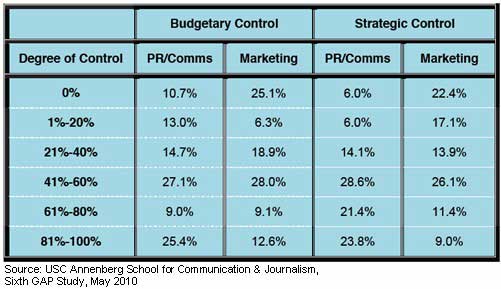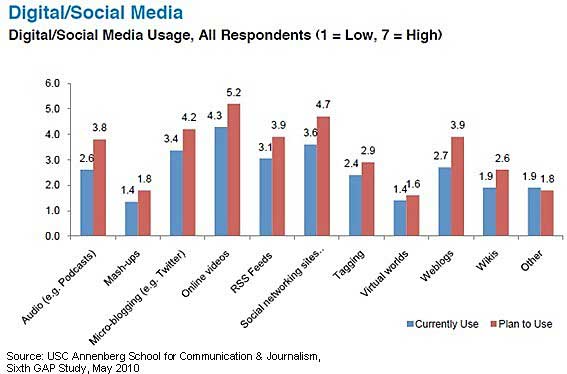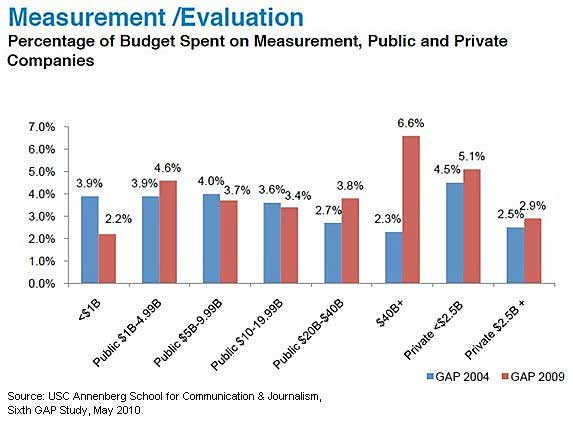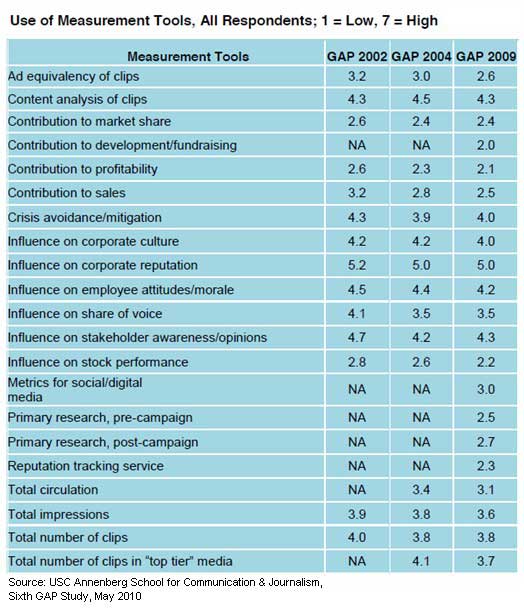New digital and social media tools are more likely to be under the strategic and budgetary control of corporate PR and communications rather than marketing departments, according to a study by the University of Southern California Annenberg School for Communication & Journalism.
One-quarter (25.4%) of surveyed communications decision-makers say PR/communication departments have 81-100% of budgetary control over digital and social media; only half as many (12.6%) say marketing has that much control.

Similarly, 23.8% say PR/communication departments have 81-100% of strategic control over new media; just 9% say marketing has that much control.
Moreover, 25.1% of communications professionals say marketing has no budgetary control over digital and social media, while just 10.7% say that of PR/communications; 22.4% say marketing has no strategic control, while just 6% say that of PR/communications.
"A very persuasive argument can be made that PR/Communication, rather than Marketing, is the logical home for these highly personal and social media, because they require a relatively noncommercial approach," said Jerry Swerling, the Strategic Communication and PR Center's director.
"They entail dialogue rather than monologue; they often convey objective information rather than product features; and they tend to be freeform in nature, which is just the opposite of the highly controlled world of Marketing."
Below, other findings from the sixth Communication and Public Relations Generally Accepted Practices (GAP) Study, published biennially by the Strategic Communication and Public Relations Center (SCPRC) at the USC Annenberg School for Communication & Journalism.
Use of Social Technologies
Overall, communications professionals report using digital and social media tools to a moderate degree, but anticipate greater planned use.
Online videos (4.3 on a usage scale of 1-7) are the most popular tool and are planned to remain so (5.2)—underscoring the importance of visual communications. The adoption level of social networking is moderate (3.6) but is planned to increase (4.7), as is the adoption and planned use of Twitter (3.4 and 4.2, respectively).

Conversely, some channels are less promising: The use of once-hot "virtual worlds" (e.g., Second Life) is now low (1.4) and is not expected to increase significantly (1.6). Similarly, the relatively low adoption of Wikis (1.9) is expected to increase just slightly (2.6).
Involvement in digital and social media goes hand in hand with how the PR/communication function is viewed internally. Those actively using new media are significantly more likely to report the following:
- Senior management takes their recommendations seriously.
- Their CEO believes that PR/communication contributes to financial success.
- Their CEO believes that PR/communication contributes to maintaining and increasing sales.
- They participate in senior-level strategic planning meetings.
Looking for real, hard data that can help you match social media tools and tactics to your marketing goals? The State of Social Media Marketing, a 240-page original research report from MarketingProfs, gives you the inside scoop on how 5,140 marketing pros are using social media to create winning campaigns, measure ROI, and reach audiences in new and exciting ways.
Measurement and Evaluation
The more a company spends on evaluation (as a percentage of the total PR/communication budget) the greater the likelihood the CEO believes that PR/communication makes a bottom-line contribution, the study finds.
Likewise, a positive correlation also exists between the percentage of the budget spent on measurement and the extent to which the CEO believes that PR/communication contributes to maintaining or increasing sales.
Yet among the communications professionals surveyed, on average only 4-5% of the total budget is allocated to formal evaluation of their work.

That low degree of investment is consistent with all five previous GAP studies, suggesting the level of actual investment in measurement lags behind the level of discussion about measurement.
"While we can't yet prove a causal relationship between what you spend on evaluation and management's attitudes, these correlations are certainly compelling and logical," Swerling said.
"CEOs love hard data. By spending more to get better data you will improve perceptions of your department. If your department is seen as a bottom-line contributor, you will probably do better at budgeting time. And if you do better at budgeting time, you will recoup your investment in evaluation."
Among the communications professionals surveyed, the top 5 metrics now used are as follows:
- Influence on corporate reputation: 5.0
- (a tie) Content analysis of clips; influence on stakeholder awareness and opinion: 4.3
- Influence on employee attitudes and morale: 4.2
- (a tie) Crisis avoidance and mitigation; influence on corporate culture: 4.0
- Total number of clips: 3.8

As in past GAP studies, no metric scored higher than 5.0, indicating there is no widely accepted approach to measurement.
Especially noteworthy are the low scores given to pre-campaign and post-campaign primary research—2.5 and 2.7, respectively—as well as the inclusion among the top 5 of the archaic "total number of clips."
About the data: A total of 382 communication decision-makers in public and private corporations, nonprofit organizations, and government agencies participated in GAP VI, for which most data was collected in the last quarter of 2009.



